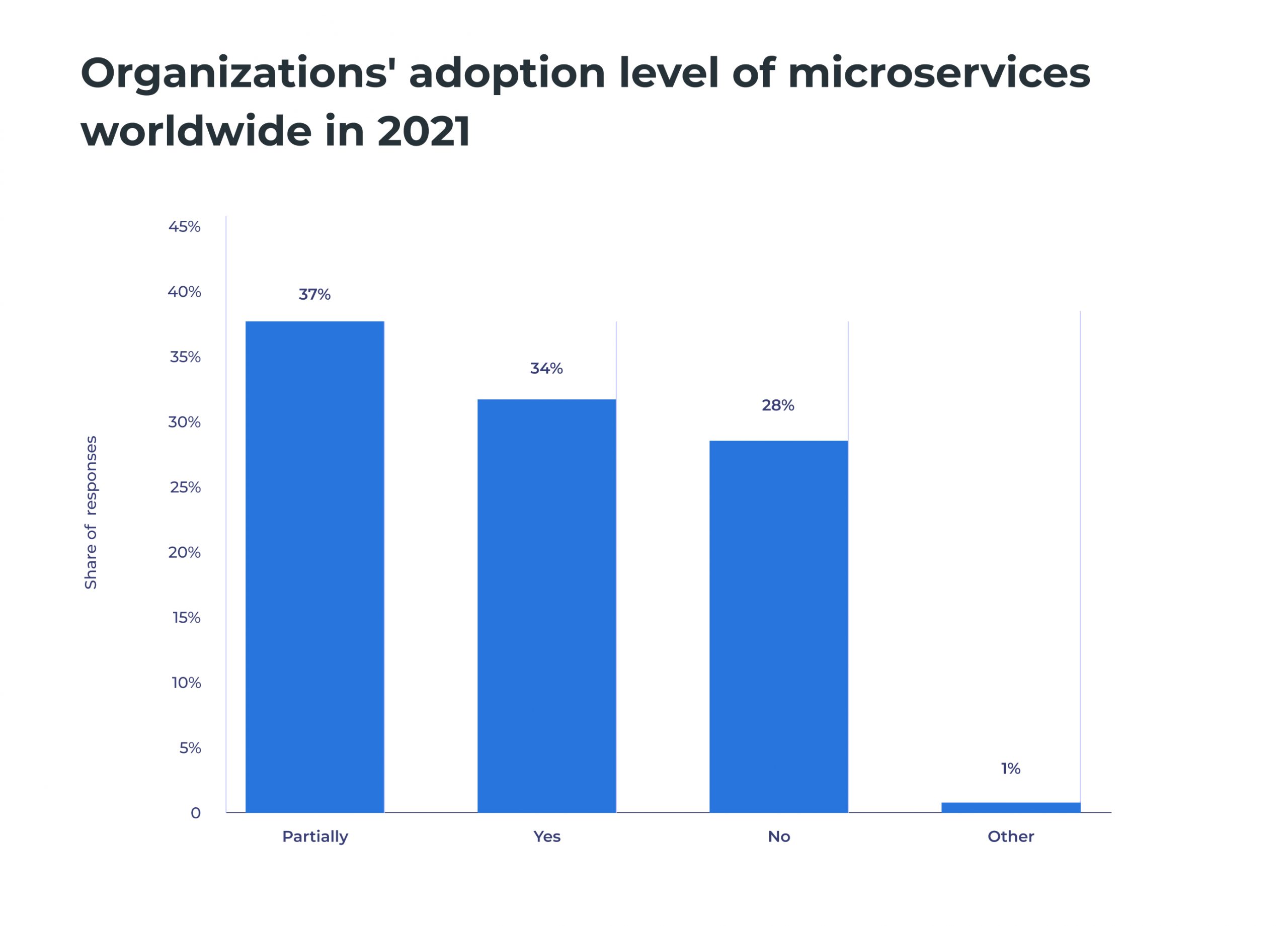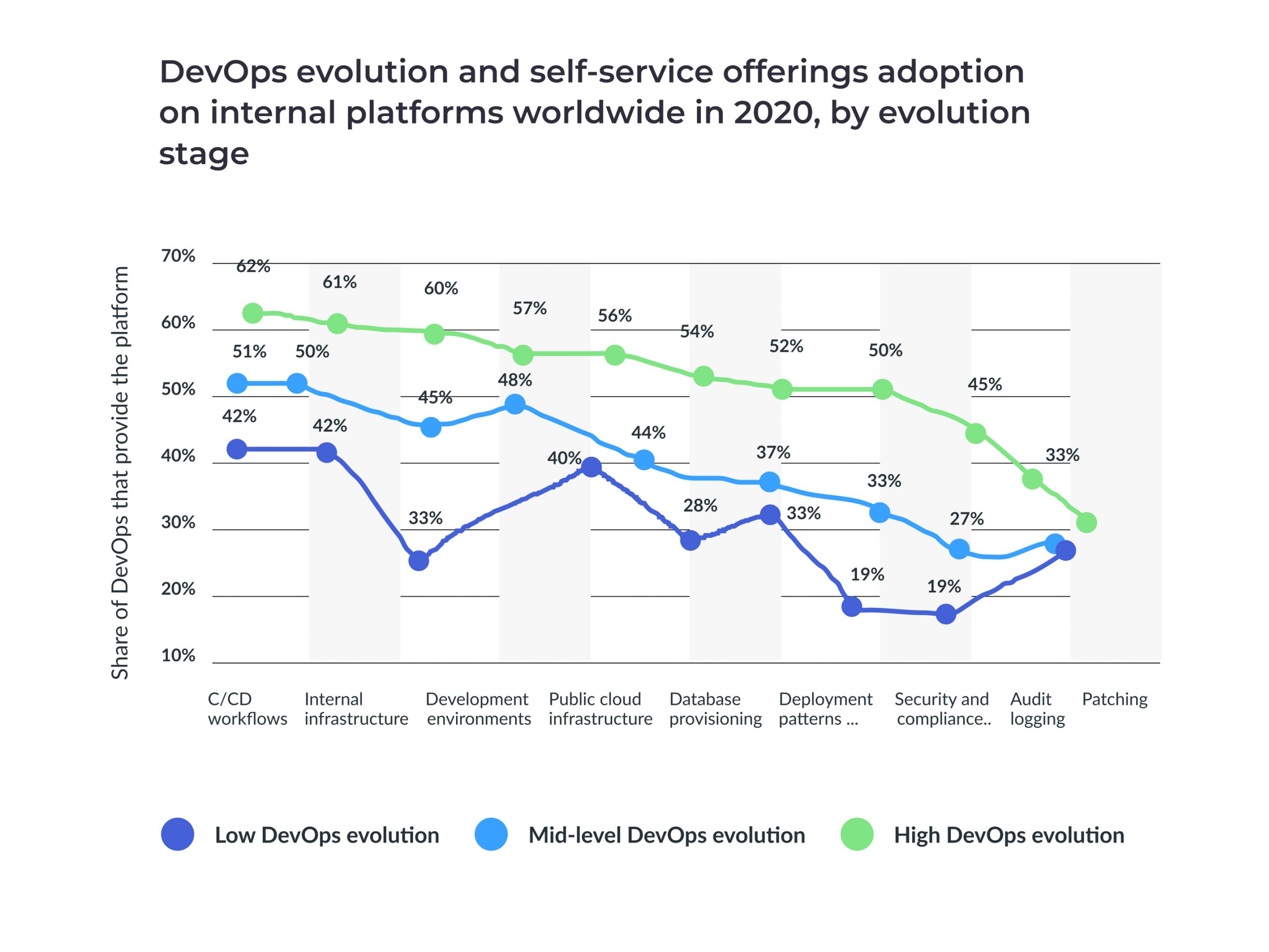A recent movement in software development has been towards creating more modular software or breaking out the different functions of an application into separate services so that each service has one job. This modular approach to software architecture is known as microservices architecture (MSA).
Though MSA has been around for several years now, there are plenty of misconceptions about how it works & how to make it work in your organization. The microservices architecture can be hard to understand at first glance. However, the benefits of microservices architecture make it worth the effort to figure out how it works & how it can help your business become more efficient, resilient, and scalable.
Multiple organizations have adopted Microservices architecture. The following infographic gives insights into the adoption level of microservices architecture.
While the adoption level still has to reach more milestones, enterprises should not shy away from implementing it into their enterprise.
Here are seven benefits of microservices architecture that depict how it’s beneficial for business and will make your company better equipped to handle change now and in the future.
Table of Contents
Have a Look at 7 Benefits of Microservices Architecture
1) Improves Productivity Effectively
The single responsibility principle isn’t just about code. It’s about ensuring that every component of your business works as efficiently as possible. And, when every element of your company has a specific purpose, it becomes easier to identify what makes sense to include in or exclude from each component. The result? You get to focus on solving one problem well instead of working on many different issues—and you get there faster!
Microservices Architecture allows the development team to break down the code into smaller fragments. It leads to better productivity and better resiliency of your application. Microservices architecture makes it easier for you to integrate new features or bug fixes with less effort than monolithic applications. They are built in a modular fashion that makes it easy to update one service at a time without affecting other services running in parallel.
Software development services companies can also deploy individual services separately so that if there are any issues with one service, it doesn’t bring down all of them at once!
Optimize your software investment with Microservices for enhanced performance.
2) Greater Resilience
Source: Statista – Cyber Attack Threat Scenarios in 2021
In recent years, companies have dealt with an onslaught of security attacks and cyber-attacks. A microservice-based architecture can allow you to build more resilient applications, thus increasing your application’s security. Since each microservice has a much smaller surface area than a monolithic application, any service is not as vulnerable to attack as a large app.
Services communicate via APIs rather than shared data stores or services. As new threats arise or old ones fade in prominence, it’s easy to address them by updating APIs rather than rewriting entire apps.
Microservices architecture allows fault isolation that can lead to faster recovery. When a single service fails, you can restart it without affecting other services. It means you can more quickly recover from outages, minimizing downtime and disruption to your business.
3) High Scalability Ensuring Uninterrupted Performance
Among notable benefits of microservices architecture, the renowned one includes the scalability that comes with it. Microservices are more straightforward to scale than monolithic applications. When you need more capacity, it’s easier to add new instances of a microservice—and only that service—as required. Since microservices don’t share data stores or services, there’s no need to worry about them interfering with each other when scaling up or down.
As the application isn’t reliant on a single codebase, it’s easier to scale your service horizontally. You can also separate an independent microservice into several teams and manage them individually. It allows one team to work on new features while another team fixes bugs in older versions of a microservice.
So, you can quickly scale your business by adding more resources as needed without affecting the existing functionality of your business. You can run multiple instances of a microservice on different servers, thereby reducing the load on each server and increasing the overall scalability of your application or website.
4) Continuous Delivery Leading to Faster Updates
The ability to easily create small building blocks that you can quickly push out to users is what many companies love about microservices. These more minor releases allow you to test feature functionality before rolling it out further and save time by not having to deal with large complex deployments at once!
Microservices architecture is effective in CI as it allows you to separate your code into different services, which you can easily update independently. It makes it easier to roll out new updates and, more importantly, roll them back if something goes wrong! It means that you can update one service without worrying about impacting other services.
Microservices also allow companies to focus on their business functionality rather than getting bogged down by infrastructure issues. Moreover, they enable software development service providers to work on specific features and then deploy them independently of each other.
Related Post- Exploring Latest Software Development Trends in 2024? Here You Go!
5) Programming Language and Technology Agnostic
While creating a microservices-based application, developers can use any language when connecting microservices. They don’t have to worry if different services use compatible technologies or languages. They need to make sure that they are all communicating via APIs and endpoints.
The following infographics provide detailed information on the preferred programming languages among microservices developers worldwide.
If one service needs to be updated or replaced with another one, it doesn’t matter what technology was used in its creation because everything gets handled at an API level. It also allows teams to work on multiple projects simultaneously and in parallel without worrying whether or not those projects will be compatible once completed.
Some challenges come with microservice architecture, but programmers can easily overcome them by adopting best practices. For example, one of these challenges could be deploying each service individually. Still, with tools like Docker containers, continuous integration, and continuous delivery platforms, it’s become more accessible than ever to deploy each service as needed.
Another challenge could be how long it takes a developer to deploy an update or fix a bug in one of their services. With technologies like Continuous Delivery and Docker containers, there is less overhead when deploying updates and fixes so that developers can get back to work faster than ever before.
6) Faster Time to Market
As you know, speed of delivery is essential. A significant benefit of moving to a microservices architecture is faster time-to-market. When teams are smaller and each can deliver more quickly, you will move from a model where your release cycles are months apart to one where they are weeks or even days apart.
It may not appear a big deal in B2B enterprises because what matters there are your gross margins. But having a product available right now when customers need it (or have an appetite for it) can be an enormous competitive advantage over rivals who keep their products in R&D mode until they feel comfortable with it.
Moreover, in B2C enterprises like Amazon and Netflix, speed to market is paramount. They have to keep adding new stuff all of the time to keep their customers engaged. So if you can move faster than your competitors in delivering new features and functionality, you will gain a significant advantage over them.
In addition to moving faster from idea to delivery with microservices architecture (MSA), you also get continuous delivery/continuous integration (CD/CI). Every time you make a change in one service or application component, it gets built and deployed automatically into production. If it doesn’t work as expected in production after deployment, your automated testing process kicks in and finds those bugs before they reach your customers.
7) Greater Business Agility and Support for DevOps
Source: Statista – DevOps & Self-Service Adoption
Even though software continues to shrink in size and increase in sophistication, applications are still too big and complicated. With a microservices architecture, numerous tiny applications (or services) make up an application. Different teams or even third-party developers can develop these. It makes it easier to test and release changes quickly.
In addition, DevOps (the collaboration of development and operations teams) requires a collaborative approach to business problem-solving where all members of an organization work together as a single unit.
When organizations use microservices architecture, they have more opportunities to get involved with DevOps consulting services. Their employees understand that they’re now part of a larger team working toward a common goal: providing outstanding products and services.
Final Words
That was all about the top benefits of microservices architecture. Overall, the microservices architecture lets you create small, independent services that can be individually scaled and updated, leading to a more flexible architecture. It’s also easier to manage because it makes code more reusable and extensible. Moreover, it facilitates the continuous delivery of features without any impediments.
However, building and managing microservice-based architecture requires effort and highly skilled professionals. It’s worth all the action when you have an agile platform to evolve with changes in business requirements.
All enterprises need continuous improvement of their technology capabilities to be competitive. Therefore, adopting microservice architectures via technology consulting services will help you improve agility in product development activities.
Enhance speed and reliability with our modular and decentralized software decelopment.
Frequently Asked Questions
Question: What are the Three Business Benefits of Microservices Architecture?
Answer: The microservices approach has three main benefits: improved Productivity, better resiliency, and increased scalability. These are important goals of most businesses, so looking at them more closely might help convince management to consider a transition to microservices architecture.
Question: How Does Microservices Architecture Help Businesses?
Answer: With a microservice approach, your business can use several independently small services that are simple to integrate and manage. For example, you can use them to handle things like paying for something on the web, checking the results of a medical test, or routing data packets.
Question: What is Meant by Microservices in Business?
Answer: For most enterprises, there are a variety of systems that must interact with running their business. It becomes more challenging to keep all these systems coordinated and updated to ensure smooth operations as a company grows.
Teams may need to refactor these systems into separate units to be maintained more efficiently and provide new services as required. It is known as microservices architecture (MSA), and it’s one of many application architectures used by modern companies today.
Question: What is the Advantage of Microservices Over Monolithic Architecture?
Answer: Monolithic systems are built as one extensive application, while microservice-based architecture breaks applications into small, single-purpose services. Developing a monolithic application may seem like a quick and easy way to get started on a project, but that’s often not true. Over time, as an application grows, it can become increasingly challenging to support and develop with multiple dependencies across several teams.
The microservice approach allows teams to work independently on individual pieces of code within their service. You can put these pieces together to form an end product through integration with other services when necessary. It makes it easier for developers to focus on specific elements of functionality and push updates more frequently.
Question: How Do Microservices Provide Small, Manageable, and Deployable Components?
Answer: Microservices provide small, manageable, and deployable components that are isolated from each other. If one part of your application has issues, then it won’t affect other parts of your application.
It breaks down large applications into smaller and more manageable components. Each element can be developed, tested, and deployed independently of other features.
As a result, microservices can help you get your application up and running faster than traditional monolithic applications. You’ll also have better control over your application’s performance because you can scale individual components as needed.
If you need to upgrade or replace a problematic component, you can without affecting any other parts of your software stack. Plus, because microservices are small and isolated, programmers can easily test them.










